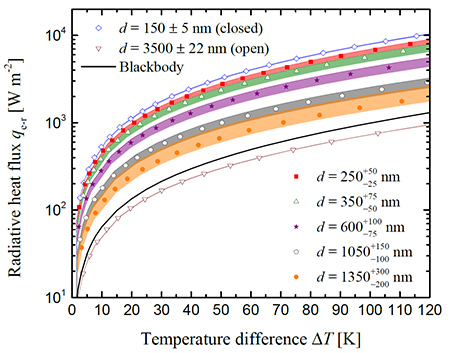In an article recently published in Nature Communications, University of Utah Mechanical Engineering students Michael Bernardi (now a Process Engineering at Intel Corporation), Daniel Milovich and professor Mathieu Francoeur measured radiative heat transfer exceeding the blackbody limit between macroscale planar surfaces separated by a nanosize vacuum gap.
In the 1970s, it was predicted that radiative heat transfer between planar surfaces separated by a vacuum gap smaller than the thermal wavelength exceeds the blackbody limit due to the contribution of waves evanescently confined within a distance of approximately a wavelength normal to the surface of a thermal source. Significant radiative heat transfer by tunneling of evanescent waves is achievable when a thermal source and a receiver are separated by a distance of a few hundreds of nanometers, at most. “The difficulty associated with maintaining a nanosize vacuum gap between macroscale planar surfaces was the main bottleneck preventing the experimental demonstration of a concept developed more than four decades ago,” Francoeur says.
Using a custom-fabricated device consisting of two planar millimeter-sized silicon surfaces separated by a tunable vacuum gap, Francoeur’s group measured a radiation heat transfer enhancement exceeding the blackbody limit by a factor of 8.4 for a 150-nm-thick gap. Francoeur continues, “Our device paves the way for the establishment of novel engineering systems capitalizing on thermally generated evanescent waves. Our ultimate goal with this research is to convert evanescent waves into electrical power. This will be done by replacing the receiver in our device by a photovoltaic cell. The possibility of harvesting evanescent waves could significantly impact waste heat recovery technologies.”
The research published in Nature Communications is funded by the National Science Foundation (Grant No. CBET-1253577).
